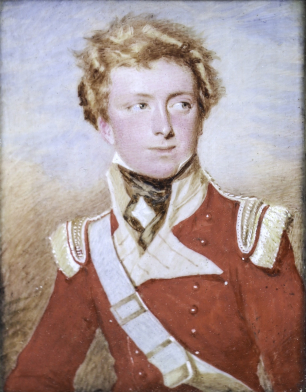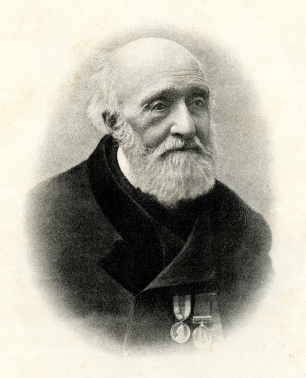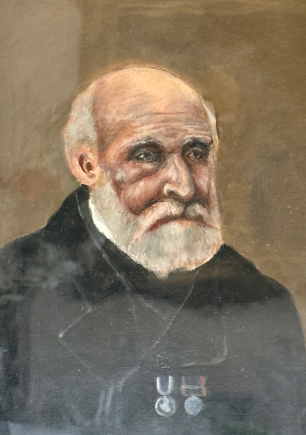Capt James Gammell
1797-1893
James Gammell was the 4th child and 2nd son of Lt. General Andrew Gammell and Martha Stageldoir, and was born on 3 January 1797. We know nothing of his early life, nor any details of his education, and the first definite information we have is that he was gazetted as an Ensign in the 59th Foot in 1813 at the age of sixteen and a half. It is understood that this commission was presented to him by Prince Frederick, Duke of York, who, as mentioned elsewhere was a friend of his father's.
Immediately on being commissioned, James proceeded to the Peninsula War and served in the Peninsula from December 1813 to the end of the war in April 1814. He fought at the battles of Nive and at the siege of Bayonne and the sortie from

Bayonne in 1814 and received the Military General Service Medal 1793-1814, with a clasp for Nive. He became a Lieutenant in 1815, saw service with the Sicilian Regiment, 61st Foot, and 64th Foot and spent some years of his service in the West Indies, before finally retiring from the Army with the rank of Captain in the Gordon Highlanders (92nd Foot) in September 1825.
In 1816, when he was nineteen, and soon after his father's death, his grandfather, James Gammell, the Banker, purchased for him the estate of Ardiffery near Cruden Bay in North Aberdeenshire. The purchase was made jointly, 'in life rent and fee respectively', which in fact meant that the income and title were vested in James, and only reverted to his grandfather in the event of the premature death of the young James. The estate of had no residence attached to it and consisted almost entirely of agricultural holdings.
A few years after he had bought Ardiffery for James, there was a serious quarrel between James and his grandfather concerning his marriage. His grandfather wished him to marry Charlotte, daughter of Lord Forbes, but it is reported that James flatly refused to do so, saying that the lady was ill-favoured, and that instead he intended to marry a beautiful Irish lady, Sydney Holmes whom he had met while serving in the Army in Ireland. Whether this was the reason why his younger brother inherited their grandfather's other landed properties rather than he, history does not relate, but it may be significant that he refrained from marrying Sydney Holmes during his grandfather's lifetime, although the wedding took place, either by accident or design, just a week after his grandfather's death.
The marriage of James to Sydney Holmes, who was the daughter of James Holmes Esq, a linen merchant in Belfast, took place on 21 September 1825. It was conducted by the Revd. E. Coates at Donaghmore Church in County Down, (Northern) Ireland, and after their honeymoon, they took up residence at a house called Beech Hill, in the same parish of Donaghmore in which they had been married, and there the first six of their ten children were born.
|
|
Born |
Died |
|
21 September 1826 |
2 November 1899 |
|
|
3 September 1827 |
23 February 1902 |
|
|
29 April 1829 |
25 September 1904 |
|
|
12 September 1830 |
3 February 1902 |
|
|
Sydney Marion |
12 November 1831 |
6 February 1837 |
|
11 or 12 July 1833 |
23 March 1882 |
|
|
Andrew Conway |
15 January 1835 |
12 December 1835 |
|
7 May 1836 |
31 July 1868 |
|
|
Andrew Conway |
5 September 1837 |
25 December 1837 |
|
27 July 1840 |
14 June 1868 |
In 1834, James and his family moved to Edinburgh, and took up residence at 52 Inverleith Row. Presumably the move had something to do with the education of their children, as immediately on arrival in Edinburgh, the eldest sons were sent to a preparatory school in Circus Place, and later to Edinburgh Academy. Their last four children were born in Edinburgh.
In 1856/7, when the education of his children at Edinburgh Academy had been completed, James and his wife moved to Bath, where the climate was no doubt more congenial, and took up residence at 16 Grosvenor Place.
Whilst in Bath he had an illegitimate daughter with a housemaid, Rebecca Rollston, who was working for the family living next door, at 17 Grosvenor Place. The child, Mary Jane Rollston was born on 25 July 1862 in Clifton and baptised on 20 August 1862. Mary was brought up by her grandparents in Claycoton, Northants and Rebecca Rollston married on 5 August 1879 and became Rebecca Dolby, who received £100 in James’ will.
From DNA evidence, it is almost certain that he also fathered a second illegitimate daughter, Jane Wheeler, who was born on 31 May 1866 (date from 1939 Register). No documentary evidence of her birth or early life has been found, but we know that she married George Edward Ford on 9 June 1885, when she did not give a father's name on the marriage certificate. Her probable illegitimacy, her strong links to the Bath area, and the clear and comparatively strong DNA links her descendants have to the Gammell family all point to James having been her father.
James lived in Bath until he died on 23 September 1893, by which time he had reached the venerable age of 96. He is buried at Locksbrook St Saviour’s Cemetery in Bath but has no headstone. His wife, Sydney, predeceased him by more than fifteen years, dying in Hampstead in on 27 February 1878 aged 80. She and five of their children are memoriaised on a gravestone in St Cuthbert’s Churchyard, Edinburgh.

James (Admiralty and Horse Guards Gazette)
At the time of his death, James' photograph appeared (full page) in the Admiralty & Horse Guards Gazette, under the title of; “Our Portrait Gallery No. 19 - The late Captain James Gammell”. There were evidently two reasons for this special honour, as the following quotations from the Gazette show. “This grand old officer was reputed to be the last commissioned veteran survivor of the Peninsula War in the British Service”, and “He served through all the Peninsula War….It seems that never having received his medal for his share in these operations having been brought recently by H.R.H. The Duke of Cambridge to the notice of Her Majesty, she presented the veteran with her Jubilee Medal, in addition to the Peninsula decoration, accompanying the gift with an expression of warm appreciation of his worth, and the hope that he might long enjoy the consideration he merited”.

In his later years James is reputed to have become rather cantankerous, to have quarrelled with his wife, and even to have thrown her out of his house. He is also said to have thrown a fine miniature of his wife by Cosway, on to the floor and stamped on it.
Although he never resided in Aberdeenshire, he became a Deputy Lieutenant of that county in 1826 and retained this position until his death. It was bestowed on him presumably on account of his ownership of the estate of Ardiffery, and possibly through the influence of the Duke of York, who had presented him with his original commission in the Army.
In his will, he left practically all his estate amounting to nearly £60,000 to his third son Harcourt. His eldest son James Stewart is not mentioned in the will, presumably as he
automatically inherited the entailed property of Ardiffery, and because this son had already inherited the estates of Drumtochty and Countesswells from his uncle, Andrew. James left his nephew Sydney Albert the sum of £3,000, and instructions to his son Harcourt to pay out to his brother Frederick (James’ second son) the sum of £70 annually. He also left several legacies to the following people: Miss Sarah Elizabeth Jones (£500), Mrs Rebecca Tolby (£100), Mrs Sophia Peacock (£50), Mrs Mary Ann Lauder (£50), Mrs Jemima Heron (£50), and Miss Maria Skipp (£200). Except for Mrs Rebecca Tolby (a misspelling of Rebecca Dolby), formerly Rebecca Rollston (see above) and Miss Maria Skipp, who was his deceased daughter-in-law Caroline’s sister, we don’t know who these people were or why he left them money. Apart from a few other small payments to servants, the residue of his estate, as has been stated, went to Harcourt absolutely.
